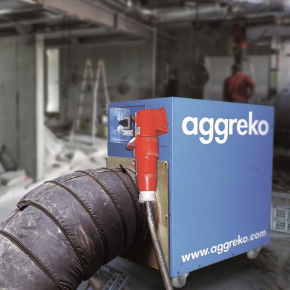
Aggreko: Are UK construction sites ready for the coldest winter on record?
 Ryan Stanley, from Aggreko‘s Temperature and Moisture Control Division, has looked at whether or not UK construction sites are prepared for what could be the coldest winter on record…
Ryan Stanley, from Aggreko‘s Temperature and Moisture Control Division, has looked at whether or not UK construction sites are prepared for what could be the coldest winter on record…
“As the UK braces for what could be one of the coldest winters since 1963, we are reminded of the infamous Beast from the East which crippled our nation last year.
With climate change rightly saturating UK headlines, we can only expect the country to experience more and more extreme weather as our planet continues to get warmer.
One industry that knows all too well about the absolute chaos that adverse weather can cause in construction. But how highly does this rank on the agenda in the planning stages of a project? I’m not so sure.
It’s not just the UK where projects fail to meet deadlines set out in the planning stages, we see it all over the world. But, worryingly, project delays and wastage are a major issue due to sites not being prepared for the unpredictable weather.
According to Construction Management and Economics, UK weather added 21% onto the duration of construction projects. Meanwhile those that planned ahead for adverse weather saw an average 16% reduction in duration time. The numbers simply do not lie.
Playing with temperatures and moisture levels
Temperature and moisture control are such crucial factors in the build stages of a project and maintaining a decent condition throughout should be paramount.
It can have catastrophic effects in terms of programme delays, which of course can see significant fines mount up but, even worse so, have a damaging effect on a site manager’s reputation along with the main contractor.
Anyone in construction knows summer seems to be the prime handover period. People buy property in the sunshine and so it makes complete sense that companies want to handover a site between April and June.
Having the foresight to get the building closed up and ready for winter is vital, but this is where many are falling down regarding the internal temperatures.
When a building shell is first constructed, the many openings created for windows leave the interior exposed to the elements. As soon as those openings are closed with windows, everything needs to be installed to a suitable temperature (normally around 10-15°C, and some hygroscopic materials at a settled RH%). If it isn’t? The consequences could be catastrophic in terms of:
– Plaster not drying out
– Flooring starts bubbling
– Paint and decorating won’t set
– Glue won’t set for hard flooring
– Electrics are unusable if surrounded by moisture
– Doors can fluctuate in size if installed in the cold then warmed up later.
The above just a couple of examples of issues sites come across and the cost implications of these things going wrong and causing wastage can be eye watering.
It’s important to remember that a concrete building will drop to a colder temperature than the weather itself. What’s more, people won’t work in those conditions so you’re at risk of workers leaving site and delaying the project further.
I like to use the analogy of making jelly when it comes to temperature control. It can’t be too hot, and it can’t be too cold.
Top tips to weather the storm
1. Get ahead of yourself – plan it in the early stages of the project by ensuring the building is closed off just before the autumn hits and make sure there is a controlled environment in place with thermostatically and humidistat-controlled equipment.
2. Create equilibrium – most importantly temperature and moisture control are two different things that need to be balanced to create the perfect environment. We can work out the perfect conditions on a site using specialist equipment.
3. Don’t ONLY heat dampness – one of the most common issues I come across is people ramping the heating up to 25 degrees on site and then opening he windows to try and push the moisture out. Not only it this using far too much energy, it is far less effective than proper dehumidification.
4. Compatibility is everything – having also seen many sites opt for cheaper dehumidifiers and expect them to work in harmony with heating equipment, it’s worth ensuring equipment is compatible and high spec to ensure you don’t run into these problems later down the line.
In terms of technological advancements, our new Aggreko Remote Monitoring system is now available for all temperature and moisture products.
This means we can log on whenever there are fluctuations in weather and plan the humidity accordingly, creating complete peace of mind for construction managers. It is also an alarmed system, notifying us and your site to any dramatic changes where action may be required.”
Visit Supplier's page
Latest news

29th April 2025
Senior pledges to ‘bee’ part of the solution with new biodiversity initiative
Senior Architectural Systems has installed its first on-site beehive, marking another step forward in its commitment to sustainability and biodiversity.
Posted in Articles, Building Industry News, Building Products & Structures, Building Services, Curtain Walling, Doors, Glass, Glazing, Innovations & New Products, news, Restoration & Refurbishment, Retrofit & Renovation, Sustainability & Energy Efficiency, Walls, Windows
29th April 2025
West Fraser range delivering key benefits for South-East carpentry company
An experienced carpenter and building site manager who has recently set up his own company is using high performance panel products from the West Fraser range.
Posted in Articles, Building Industry News, Building Products & Structures, Building Systems, Case Studies, Garden, Restoration & Refurbishment, Retrofit & Renovation, Sustainability & Energy Efficiency, Timber Buildings and Timber Products
29th April 2025
CPD Courses Available Online From Ecological Building Systems
Ecological Building Systems, a leading supplier of natural building products for sustainable construction, has revealed its comprehensive CPD programme for the year ahead.
Posted in Articles, Building Industry Events, Building Industry News, Building Products & Structures, Building Services, Continuing Professional Development (CPD's), Information Technology, Innovations & New Products, Insulation, Restoration & Refurbishment, Retrofit & Renovation, Seminars, Sustainability & Energy Efficiency, Training, Walls, Waste Management & Recycling
29th April 2025
WindowBASE launches new prospect databases at FIT Show
Visit WindowBASE at the FIT Show to see first-hand how it helps companies find new customers – the company is launching an easy-to-use, intuitive platform on Stand G16 at the NEC Birmingham from 29th April – 1st May.
Posted in Articles, Building Industry Events, Building Industry News, Building Products & Structures, Building Services, Doors, Exhibitions and Conferences, Glass, Glazing, Information Technology, Innovations & New Products, Posts, Publications, Research & Materials Testing, Restoration & Refurbishment, Retrofit & Renovation, Windows
 Sign up:
Sign up: